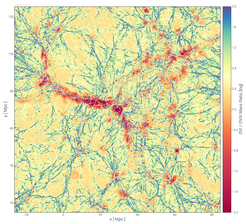Oxygen, after hydrogen and helium, is the most abundant element in the universe. It is a fundamental tracer to learn more about the formation of single stars as well as entire galaxies. Understanding the origin of highly excited states of oxygen in the circumgalactic medium (CGM) around galaxies has proven difficult, and past theoretical models have had difficulty matching observational constraints. Using cosmological simulations from the IllustrisTNG suite, researchers at MPA have demonstrated how the feedback from supernovae and supermassive black holes can shape the heavy element content of the CGM, bringing it into agreement with data from the local universe. The amount of highly ionized oxygen around blue, star-forming galaxies is predicted to be noticeably higher than around red, quenched systems of exactly the same mass. 
As the dominant “metal” (i.e. element heavier than hydrogen or helium) in the interstellar, circumgalactic, and intergalactic media, oxygen is one of the most important elements in astrophysics. Observations of oxygen in its various forms underpin much of our understanding of galaxy formation and evolution. In its three highest observable ionization states – OVI, OVII, and OVIII – oxygen traces gas which is either hot, at temperatures above 100,000 Kelvin, or at low densities, with less than 100 atoms per cubic meter. All three ions can arise in the rarefied plasmas which surround galaxies and extend out to large distances, into their hot gaseous halos, which are commonly referred to as the intra-cluster medium (ICM) or circumgalactic medium (CGM), depending on the mass of the dark matter halo. These highly ionized states of oxygen also emerge in the low gas density structures which make up the topology of the cosmic web of large-scale structure: the intergalactic medium (IGM). See:http://www.mpa-garching.mpg.de/556989/hl201807 |
